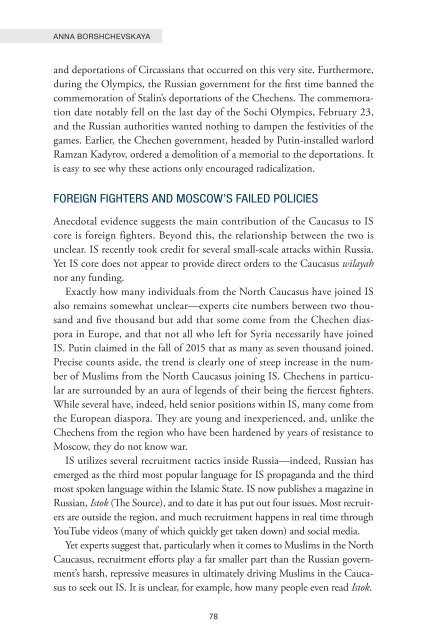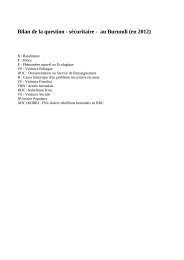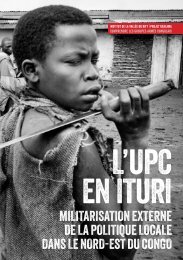You also want an ePaper? Increase the reach of your titles
YUMPU automatically turns print PDFs into web optimized ePapers that Google loves.
ANNA BORSHCHEVSKAYA<br />
and deportations of Circassians that occurred on this very site. Furthermore,<br />
during the Olympics, the Russian government for the first time banned the<br />
commemoration of Stalin’s deportations of the Chechens. The commemoration<br />
date notably fell on the last day of the Sochi Olympics, February 23,<br />
and the Russian authorities wanted nothing to dampen the festivities of the<br />
games. Earlier, the Chechen government, headed by Putin-installed warlord<br />
Ramzan Kadyrov, ordered a demolition of a memorial to the deportations. It<br />
is easy to see why these actions only encouraged radicalization.<br />
FOREIGN FIGHTERS AND MOSCOW’S FAILED POLICIES<br />
Anecdotal evidence suggests the main contribution of the Caucasus to IS<br />
core is foreign fighters. Beyond this, the relationship between the two is<br />
unclear. IS recently took credit for several small-scale attacks within Russia.<br />
Yet IS core does not appear to provide direct orders to the Caucasus wilayah<br />
nor any funding.<br />
Exactly how many individuals from the North Caucasus have joined IS<br />
also remains somewhat unclear—experts cite numbers between two thousand<br />
and five thousand but add that some come from the Chechen diaspora<br />
in Europe, and that not all who left for Syria necessarily have joined<br />
IS. Putin claimed in the fall of 2015 that as many as seven thousand joined.<br />
Precise counts aside, the trend is clearly one of steep increase in the number<br />
of Muslims from the North Caucasus joining IS. Chechens in particular<br />
are surrounded by an aura of legends of their being the fiercest fighters.<br />
While several have, indeed, held senior positions within IS, many come from<br />
the European diaspora. They are young and inexperienced, and, unlike the<br />
Chechens from the region who have been hardened by years of resistance to<br />
Moscow, they do not know war.<br />
IS utilizes several recruitment tactics inside Russia—indeed, Russian has<br />
emerged as the third most popular language for IS propaganda and the third<br />
most spoken language within the Islamic State. IS now publishes a magazine in<br />
Russian, Istok (The Source), and to date it has put out four issues. Most recruiters<br />
are outside the region, and much recruitment happens in real time through<br />
YouTube videos (many of which quickly get taken down) and social media.<br />
Yet experts suggest that, particularly when it comes to Muslims in the North<br />
Caucasus, recruitment efforts play a far smaller part than the Russian government’s<br />
harsh, repressive measures in ultimately driving Muslims in the Caucasus<br />
to seek out IS. It is unclear, for example, how many people even read Istok.<br />
78






